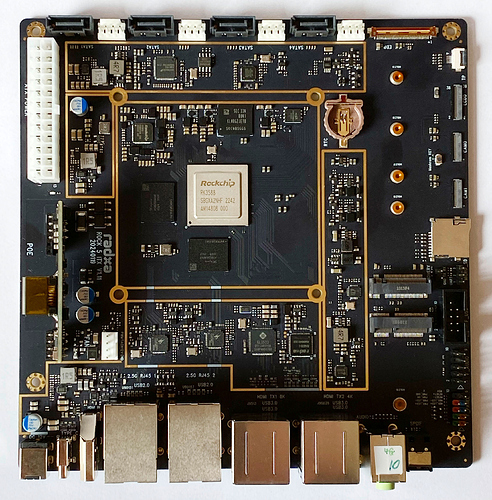Ah yes! given there was an arrow in front of the button, I thought you meant it. Yes I definitely noticed the F_PANEL, that was mentioned earlier in the thread, I didn’t notice the on-board marking indicating its presence. Good point!
ROCK 5 in ITX form factor
I am really looking forward to this version of rock5 to build a sata NAS. Seems to have the perfect amount of ports now
Hah yeah, sorry, I can see the confusion now! Seems I was a bit “short” this morning before my coffee 
Does anyone have any benchmark results for the RK3588 with LPDDR4X vs LPDDR5 (CPU and/or GPU)? I’m assuming that the LPDDR5 chips are a higher speed grade than the 4266 we see in the Rock 5B…
I guess we should also see a slight drop in power consumption with the upgrade?
Since the DRAM initialization BLOB is called rk3588_ddr_lp4_2112MHz_lp5_2736MHz_v1.1X.bin since ages we might expect the LPDDR5 maxing out at 5472 MT/s.
Good pickup  Thanks!
Thanks!
Not if you also upgrade your software since every HW improvement gets immediatly ruined by SW.
Fun fact: using mainline kernel instead of BSP kernel at least with Rock 5B results in 2W more idle consumption and ruined performance under full load when passively cooled: https://github.com/ThomasKaiser/Knowledge/blob/master/articles/Quick_Preview_of_ROCK_5B.md#revisiting-software-support-status-20-months-later
The very first time I tried the mainline kernel last year I found that it generates more heat even when it is idle (since I have been using passive cooling). So I still won’t be using the mainline kernel for daily use in the short term.
And thats the exact reason i do not use mainline kernel yet, in the clock driver a lot is missing and the power domains, there is just nothing. The thing is running like it is on threadmill all the time.
Since developer samples are on their way I would like to ask about software support status. @RadxaYuntian
Judging by commit history / PRs the linux-5.10-gen-rkr3.4 branch is the one with most updated DTS, correct? At least in the linux-5.10-gen-rkr4.1 branch the whole rk3588-rock-5-itx.dts file is completely missing…
So with which settings / kernel branch to start?
linux-5.10-gen-rkr3.4 is the one for all RK3588 & RK3399 devices. The actual code is then adjusted by the build tool to enable a common feature set and some other changes that I see fit for my operating system maintainer purpose.
Thank you!
Are we expected to see new releases appearing here https://github.com/radxa-build/rock-5-itx/releases/ soon?
I have not heard any news in this regard. Current focus is CM5 and Rockchip Linux 6.1 SDK.
Edit: was just told that we are about to create the RC image.
Any updates on a likely release date?
Ah, good to know  Thanks for the heads up!
Thanks for the heads up!
I have this beauty now on my desk:
I used a preliminary OS image from Radxa to check some stuff by running sbc-bench -r: https://github.com/ThomasKaiser/sbc-bench/blob/master/results/reviews/Radxa-Rock-5-ITX.md
Forget about the performance numbers present there since there’s something wrong with DRAM initialization. While the two SK Hynix 32Gb LPDDR5 modules should be faster than the LPDDR4X on Rock 5B (4224 vs. 5472 MT/s) memory bandwidth hasn’t improved and latency is worse compared to LPDDR4X.
The good thing to report is that the board is lying flat on a table at 23°C ambient temp with neither heatsink nor fan and not even the rather demanding cpuminer benchmark led to throttling since temps remained below 76°C 
As for the hardware just as quick addendum to sbc-bench -r info collected above: there’s a Genesys Logic GL3523 USB3 hub on the board and also a Terminus Technology Inc. USB2 hub.
Idle consumption with all governors set to powersave and nothing connected except TF card, the (optional) PoE module and one Ethernet jack at GbE speed is 4.00W according to my ODROID SmartPower 3 (5.3W with governors set to performance).
But just like the benchmark scores above this is BS at this point in time since settings haven’t matured yet.
It looks really nice and high quality. I’m also noticing a chip marked “Radxa” there. It reminds me the first time I saw “Asus” marked on a chip several decades ago 
What we really need nowadays will be to make interchangeable DRAM modules based on LPDDR so that even if the SoC cannot support standard SODIMM, it should be possible to design an alternative. I initially thought that a tiny PCB with two chips on top and tin balls underneath could be pressed using screws against the main board, but after all, there are plenty of connectors that could probably support multi-chip LPDDR frequencies and make such SBCs much more modular.
It looks really nice and high quality. I’m also noticing a chip marked “Radxa” there. It reminds me the first time I saw “Asus” marked on a chip several decades ago
